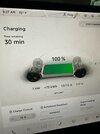Side note:
I had to help my parents with a dead Automower (robot lawn mower) today.
Could not be started, did not take charge.
Most probably they forgot to shut it down and maybe even to get it fully charged before the winter. (Stowed away ~ 9 months ago). Battery did look “dead”.
Opened the robot, took out the battery (5 18650 in series). Each cell was 0.9-1.1V which is waaay below the 2.5V end of discharge for these cells.
I charged with one of my many hobby lithium chargers. Circumnavigated the BMS and charged right on the end if the cells. After filling up ~50% of the charge I put the robot together and started it, and charged in the charging station.
All good, filled up to 100% as as far as it looks it has not lost any capacity from last year.
Charging at a safe place, just in case it was anything wrong causing a fire.
View attachment 1052952



